Jaw Fractures
Fractures of the jaw are usually the result of being hit by a car, but some do occur because a dog has collided with something whilst carrying an object in their mouth (e.g. a rugby ball!). These fractures are seen at Weighbridge Referral Centre infrequently as many can be managed in Primary Care Veterinary Practices. In addition, the most important aspect of their treatment is the affect they have on the alignment of the dog’s teeth and so many fractures of the jaw are best treated by a Veterinary Dentist. Those seen here are generally fairly “simple” fractures that need stabilising using plates or frames similar to those used for Long Bone fractures. Our familiarity with these techniques, when required, is the reason for some patients with these injuries being referred to Weighbridge Referral Centre.

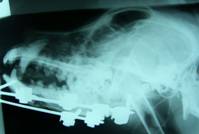

Fractures affecting Joints
Fractures affecting joints are seen regularly at Weighbridge Referral Centre. Sometimes they are associated with Dislocations. The two most commonly affected joints are the elbow and the hip (see under Fractures – Pelvic). Within the elbow it is most often the bottom end of the humerus (bone in the “upper arm”) that becomes fractured – usually as the result of landing awkwardly from a jump or fall, but sometimes because of being hit by a car. Such a fracture is very disabling and without surgical treatment the outcome is generally poor with little function returning to the leg because of the affect it has on the elbow joint. When the bottom of the humerus fractures it either does so in a way that breaks off either one or two pieces. When two pieces break off, the fracture is often referred to as a “Y fracture” because of its appearance on an X-ray.

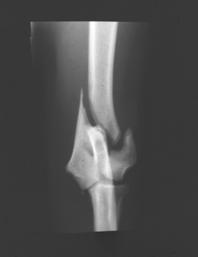
Fracture affecting one side Fracture affecting both sides of bone (humerus)
– Lateral condylar fracture – “Y fracture”
Treatment of these fractures can be very difficult but it is important to put the pieces back very accurately if elbow function is to return to anything like normal. In the case of a “Y fracture” this will often require a combination of pins, bone screws and bone plates. The success rates for return to function in the limb will depend on such factors as:
- the type (configuration) of the fracture
- patient’s age (and possibly size)
- surgeon’s experience
- available equipment.
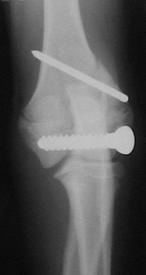

Reviewing the cases treated at Weighbridge Referral Centre suggests the success rates for return of good or excellent function is about 90% in the case of fractures involving only one side of the bone and about 70% in cases with a “Y-fracture”.
Fractures affecting Long Bones
These are the commonest fractures treated at Weighbridge Referral Centre and are most often the result of being hit by a car. Some of the bones are broken in just one place (“simple”) whilst others are broken into several pieces (“comminuted”). In a few cases the pieces of bone have punctured the skin in which case the fracture is referred to as “open”.
Although some of these fractures can be treated using a cast, there can be problems with joint stiffness and muscle wastage even when the bone heals successfully. Also casts can be problematic in terms of causing sores and needing changing during the period of treatment. Modern treatments for long bone fractures aim to allow controlled use of the leg whilst the bone heals. This avoids most of the problems relating to muscle wastage and joint stiffness.
The choice of management for a particular fracture is quite complex but in general terms the two most commonly used techniques are internal or external fixation. Internal fixation will, most often involve stabilising the main bone fragments with a combination of bone screws and plates whilst external fixation involves the placement of pins into the fragments of bone through the skin and then connecting these pins together with clamps and bars, outside the leg.
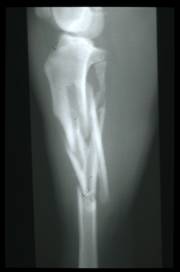



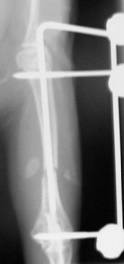
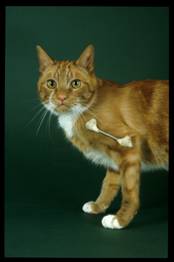
With accurate use of an appropriate technique it is usually possible to regain very good or excellent function in a limb following fracture involving a long bone. The healing time depends on the nature of the fracture and the age of the patient but can range from 4 weeks to 4 months (even with ideal conditions).
Fractures affecting the Pelvis
Dogs and cats with pelvic fractures are seen regularly at Weighbridge Referral Centre and are almost always the result of being hit by a car. Both sides of the pelvis can often be involved, making it very difficult for the patient to use either of his/her back legs. The main concerns relating to these fractures are:
- Lack of mobility (especially if both sides of the pelvis are involved)
- Pain – sometimes severe because of the bone fragments touching nerves
- Bone fragments pushing into the pelvic canal – reducing the space for the structures that should be there (including the bowel)
- Hip joint – this can be affected directly (fracture through the socket) or indirectly (bone fragments pushed out of position causing distortion of the socket
Many of these fractures can be successfully managed with conservative treatment – that is to say restriction of activity (pen / cage rest), pain killers and assistance to get out to the toilet if necessary. However, surgery, in general, will allow a more rapid (and possibly more complete) recovery and make management easier in terms of better mobility and less pain during the recovery period. In most cases the surgery will involve realigning the pelvis on one or both sides and stabilising the bones using plates and screws.


Complications can be seen but a good recovery of function and mobility can generally be the anticipated outcome.
Fractures affecting the Spine
These are uncommon injuries and usually result from being hit by a car. Like all fractures they result in pain but in the case of fractures of the vertebrae in the neck or back the injury can also involve the spinal cord resulting in partial or complete paralysis. Unfortunately, in some cases the injury to the spinal cord is so severe that recovery of function is impossible but, fortunately, in most cases the injury to the spinal cord is either relatively mild and/or is reversible.
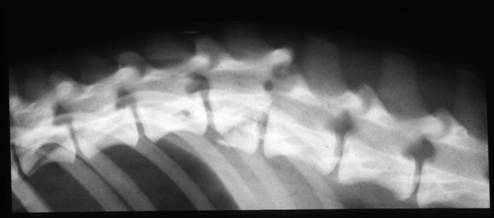
Many of these fractures are stable and can be treated conservatively. This involves cage / pen rest for a few weeks, painkillers and possibly physiotherapy as healing starts to take place. However, in those that are unstable the pain may be severe or damage to the spinal cord may continue to worsen as the bones move around. In such cases it is better to consider surgical stabilisation with some urgency since further damage to the spinal cord is to be avoided whenever possible. During surgery the bones are re-aligned and held in this position with orthopaedic implants. At Weighbridge Referral Centre the commonest way of stabilising these fractures involves bone screws, either in combination with a bone plate or else using bone cement to bind the screw heads together (because the shape of the vertebrae can be too irregular to allow a plate to be applied). Following surgery it is generally recommended that the patient is enrolled for a programme of physiotherapy to help them regain the best possible use in their legs.

Fractures affecting young puppies & kittens
Unfortunately, puppies and kittens suffer their fair share of fractures. Because they are still growing they have what are referred to as “growth plates” in their bones. These are plates of cartilage from where the bone is produced to make them grow longer. Because cartilage is weaker than bone itself if these patients are injured then it is more likely the bone will fracture through a growth plate than through the bone itself. Because these are close to joints the effect that can be seen in terms of joint alignment can be very marked and although the fracture might heal without any intervention there will be a deformity close to the joint that might compromise limb function. A good example of this is fracture of the bone just above the knee where the end becomes very rotated because of pull from the hamstring muscles, or at the other end of this bone, close to the hip:

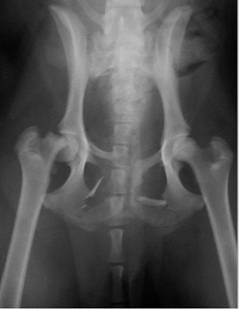
Fractures of growth plates, unless they show minimal displacement, are best treated surgically. After careful repositioning of the end of the bone onto the main shaft, the fracture is usually stabilised using small pins as these have less effect on any ongoing growth from the damaged cartilage.
